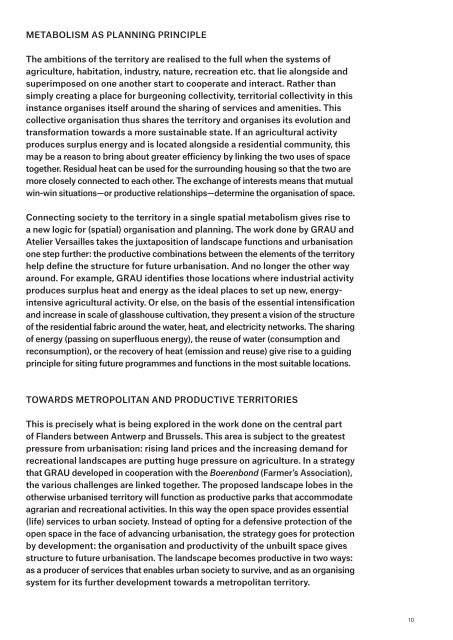The Ambition of the Territory Belgian Pavilion, 13th International Architecture Exhibition, La Biennale di Venezia 2012
You also want an ePaper? Increase the reach of your titles
YUMPU automatically turns print PDFs into web optimized ePapers that Google loves.
METABOLISM AS PLANNING PRINCIPLE<br />
<strong>The</strong> ambitions <strong>of</strong> <strong>the</strong> territory are realised to <strong>the</strong> full when <strong>the</strong> systems <strong>of</strong><br />
agriculture, habitation, industry, nature, recreation etc. that lie alongside and<br />
superimposed on one ano<strong>the</strong>r start to cooperate and interact. Ra<strong>the</strong>r than<br />
simply creating a place for burgeoning collectivity, territorial collectivity in this<br />
instance organises itself around <strong>the</strong> sharing <strong>of</strong> services and amenities. This<br />
collective organisation thus shares <strong>the</strong> territory and organises its evolution and<br />
transformation towards a more sustainable state. If an agricultural activity<br />
produces surplus energy and is located alongside a residential community, this<br />
may be a reason to bring about greater efficiency by linking <strong>the</strong> two uses <strong>of</strong> space<br />
toge<strong>the</strong>r. Residual heat can be used for <strong>the</strong> surroun<strong>di</strong>ng housing so that <strong>the</strong> two are<br />
more closely connected to each o<strong>the</strong>r. <strong>The</strong> exchange <strong>of</strong> interests means that mutual<br />
win-win situations—or productive relationships—determine <strong>the</strong> organisation <strong>of</strong> space.<br />
Connecting society to <strong>the</strong> territory in a single spatial metabolism gives rise to<br />
a new logic for (spatial) organisation and planning. <strong>The</strong> work done by GRAU and<br />
Atelier Versailles takes <strong>the</strong> juxtaposition <strong>of</strong> landscape functions and urbanisation<br />
one step fur<strong>the</strong>r: <strong>the</strong> productive combinations between <strong>the</strong> elements <strong>of</strong> <strong>the</strong> territory<br />
help define <strong>the</strong> structure for future urbanisation. And no longer <strong>the</strong> o<strong>the</strong>r way<br />
around. For example, GRAU identifies those locations where industrial activity<br />
produces surplus heat and energy as <strong>the</strong> ideal places to set up new, energyintensive<br />
agricultural activity. Or else, on <strong>the</strong> basis <strong>of</strong> <strong>the</strong> essential intensification<br />
and increase in scale <strong>of</strong> glasshouse cultivation, <strong>the</strong>y present a vision <strong>of</strong> <strong>the</strong> structure<br />
<strong>of</strong> <strong>the</strong> residential fabric around <strong>the</strong> water, heat, and electricity networks. <strong>The</strong> sharing<br />
<strong>of</strong> energy (passing on superfluous energy), <strong>the</strong> reuse <strong>of</strong> water (consumption and<br />
reconsumption), or <strong>the</strong> recovery <strong>of</strong> heat (emission and reuse) give rise to a gui<strong>di</strong>ng<br />
principle for siting future programmes and functions in <strong>the</strong> most suitable locations.<br />
TOWARDS METROPOLITAN AND PRODUCTIVE TERRITORIES<br />
This is precisely what is being explored in <strong>the</strong> work done on <strong>the</strong> central part<br />
<strong>of</strong> Flanders between Antwerp and Brussels. This area is subject to <strong>the</strong> greatest<br />
pressure from urbanisation: rising land prices and <strong>the</strong> increasing demand for<br />
recreational landscapes are putting huge pressure on agriculture. In a strategy<br />
that GRAU developed in cooperation with <strong>the</strong> Boerenbond (Farmer’s Association),<br />
<strong>the</strong> various challenges are linked toge<strong>the</strong>r. <strong>The</strong> proposed landscape lobes in <strong>the</strong><br />
o<strong>the</strong>rwise urbanised territory will function as productive parks that accommodate<br />
agrarian and recreational activities. In this way <strong>the</strong> open space provides essential<br />
(life) services to urban society. Instead <strong>of</strong> opting for a defensive protection <strong>of</strong> <strong>the</strong><br />
open space in <strong>the</strong> face <strong>of</strong> advancing urbanisation, <strong>the</strong> strategy goes for protection<br />
by development: <strong>the</strong> organisation and productivity <strong>of</strong> <strong>the</strong> unbuilt space gives<br />
structure to future urbanisation. <strong>The</strong> landscape becomes productive in two ways:<br />
as a producer <strong>of</strong> services that enables urban society to survive, and as an organising<br />
system for its fur<strong>the</strong>r development towards a metropolitan territory.<br />
10


















